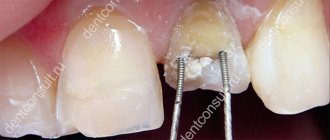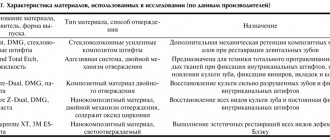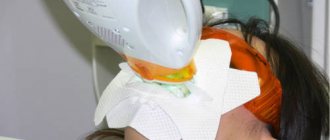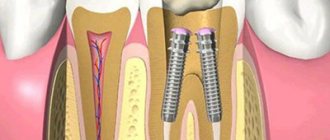Why install the pin?
The pin is installed in the tooth cavity for the purpose of:
- improving the fixation of the filling (in such cases, preference is given to fiberglass or ceramic products, since they do not shine through the composite restoration, thereby not disturbing aesthetic indicators);
- formation of a tooth stump from a filling material, followed by the manufacture of a crown for this tooth (in this clinical situation, installation of metal products is possible).
Pins are recommended for use in cases of significant destruction of the tooth crown due to caries, trauma, or increased abrasion of hard tooth tissues. They can also be used by dentists for restorations of the frontal group of teeth in case of their significant inclination.
What types are there?
Dental rods are classified according to several parameters:
- According to the material. Made from various types of metals (anchors) and polymers. The latter are made of ceramic composite, carbon fiber, and fiberglass.
- According to the method of fastening. Classic (intracanal) and parapulpal (fixed in the coronal part).
- By type of fixation. Active (screwed into the root canal) and passive (attached to cement).
- According to the form. Screw, conical, cylindrical, cylindrical-conical.
- According to the manufacturing method. Factory (standard) and individual, made for a specific patient.
Anchor pins
The choice of one or another type of pin is determined in each case individually. It depends on:
- degree of destruction of the crown and root system;
- the area being restored - front or rear units;
- structure of the root canal;
- planned load on the tooth: the highest is for chewing teeth under crowns, the lowest is for frontal units with composite fillings;
- presence/absence of allergies to a certain material;
- aesthetic requirements;
- wishes and financial capabilities of the patient.
Metallic and non-metallic: types of pins made of different materials
Materials for making pins are divided into 2 large groups: metals and polymers. The latter have better aesthetics, they better distribute the load on the root system, but they are also more expensive.
Anchor
This type includes pins made of any type of metal. It could be:
- titanium is the most durable and biocompatible;
- gold;
- platinum;
- palladium;
- medical steel.
Anchor pins are reliable and durable, they are used in all clinics.
Anchor rods are durable and cheap. They are used in every clinic. But they have significant disadvantages:
- are not suitable for restoring anterior teeth with fillings, because shine through the composite;
- possible allergies;
- not flexible, so the entire load falls on the canal wall, which threatens root splitting or perforation: according to the online magazine for dentists Dental Magazine (https://dentalmagazine.ru/posts/kak-pravilno-vybrat-steklovolokonnye-shtifty.html) root canal fracture is observed in 9% of patients with cast structures during the first 4 years;
- they distribute the load when chewing worse than other types;
- the anchor cannot be removed from the tooth without breaking the root.
Fiberglass
Fiberglass pins are a quality alternative to metal ones. They are superior to anchor rods in many ways:
- do not show through the composite, therefore suitable for restoration of canines and incisors;
- root fracture is excluded, because elastic pins;
- biocompatible, do not cause allergies;
- can be easily pulled out without the risk of damaging the channels;
- allow you to reduce the load on the root.
Anchor pins are not suitable for prosthetic restorations of anterior teeth
At the same time, fiberglass pins are more fragile than metal ones, so they are preferred to restore the front group of teeth. They are also more expensive than anchor structures.
Carbon fiber
Hydrocarbon rods combine the best qualities of anchor and fiberglass structures. They:
- elastic;
- high strength;
- distributes the load better than other types;
- lungs.
Carbon fiber rods are universal, suitable for any group of teeth. If possible, choose them: they are the best, and the price is the same or even lower than fiberglass products.
Ceramic
Another alternative to metal pins is zirconia ceramic rods. They have:
- high bending strength;
- excellent aesthetics - similar in color to dentin tissues, do not show through translucent crowns;
- biocompatibility;
- stability - do not change color, do not corrode.
Ceramic structures are made using direct and indirect methods. In the first, the pin is formed directly in the oral cavity from composite materials, and in the second, the rod is made in a dental laboratory from ceramics.
Ceramic pins are similar in color to dentin
However, ceramic products have significant disadvantages:
- high fragility;
- difficulty in extraction during repeated treatment - as a rule, the tooth has to be removed along with the ceramic rod;
- high price - minimum 2,000 rubles.
But the main thing is that very few clinics work with ceramic pins. Even in Moscow there are only a few such dentists.
Varieties according to the method of attachment: intracanal and parapulpal
You can secure the dental pin in 2 ways: classic, in the root canal, and minimally invasive, in the coronal part.
In-canal
Intracanal pins are installed in the root canal. If the tooth is not dead, it is first depulped (the nerve is removed), all canals are filled and the mouth is prepared - it is widened and deepened. Afterwards the rod is screwed in or fixed to cement.
This approach allows:
- securely fix the structure;
- achieve high strength restoration.
However, fixation in the canal is a complex and delicate manipulation. Incorrect actions lead to root fracture and subsequent tooth extraction. But experienced doctors do not have such problems.
Intracanal pins are installed in root canals
Parapulpal
Parapulpal pins are called pins or micropins. They are installed in the coronal part without affecting the canals and root system: a channel is drilled directly into the dentin (the inner layer of the tooth under the enamel), into which the rod is then screwed.
Pins are used for:
- chipped cutting edges near the front teeth;
- fractures of the chewing tubercles of premolars and molars;
- damage to contact surfaces.
Micropins are always made of metal alloys.
Pins are an outdated technology. They are not suitable for restoring heavily damaged units. Their use was justified earlier, when chemical-curing fillings were widely used. Modern photocuring composites make it possible to restore tooth surfaces without parapulp pins.
However, when only the dentinal layer is destroyed without damage to the pulp chamber, fixation of the pin takes priority over the intracanal pin. Parapulpal rods allow:
- avoid depulpation;
- restore a tooth with minimal invasiveness;
- carry out restoration as quickly as possible - in one visit lasting up to an hour;
- strengthen the walls of the crown;
- It is easy to remove the pin without damaging the root if you need to re-treat the unit.
Depending on the type of fixation, there are active and passive pins
Active and passive: classification by type of fixation
There are 2 ways to secure the intracanal rod: screw it in (active fixation) or place it on cement (passive fixation).
Active
Active pins have a screw thread at the root, thanks to which the rod is screwed into the canal like an implant.
Thanks to the thread, the active rod is fixed more firmly, does not fall out and can withstand heavy loads. But with this method of extension, perforations and root splits often occur. Therefore, the technique is justified only in 2 cases:
- with severe tooth decay - affecting over 70% of the crown and partially the root system;
- if prosthetics are planned in the future, pins with screw threads cope with loads better than passive ones.
Passive
Passive pins most often have a cylindrical shape and a smooth surface without threads. They are easy to install: after expanding the mouth, they are “set” on cement.
The passive method of fixation is simpler than the active one. Because during installation there is no pressure on the canal walls, the risk of perforation or splitting of the root wall is minimal.
True, the retention (stability) of passive pins is worse than that of active ones. But due to rare negative consequences, such rods are installed most often.
Depending on the type of fixation, there are passive and active pins
Variety of pin shapes
The pins are made in 4 shapes:
- screw - these are active threaded pins;
- cylindrical – the most stable;
- conical - most closely match the shape of the root canals;
- combined or cylindrical-conical - combine the high retention of cylindrical rods and the anatomical conformity of conical rods.
The shape of the pin is selected individually for each tooth. The structure, width and curvature of the root canal are taken into account.
Pins with a cylindrical-conical shape are considered the best. They are similar in structure to natural teeth: the rods have a reduced diameter in the apical (root) part and an increased diameter in the coronal part. Thanks to this, the structures are firmly fixed, do not fall out and distribute the load evenly.
An individual pin shape is selected for each tooth.
Methods for making pins
Another classification of dental posts is related to the manufacturing method. There are:
- factory or standard - produced in sets, each of which has 3-10 rods of different lengths and shapes;
- individual: made taking into account the structure of the canals of a particular tooth: maximum transmission of anatomical nuances ensures more durable fixation and reduces the risk of root damage during installation.
Prefer custom pins whenever possible. They are better than factory ones, and are not much more expensive. True, most clinics work with standard rods, because... no need to waste time and resources on manufacturing structures.
Pin installation process
Since such structures are installed at the root of a tooth, the root canal must be hermetically sealed over its entire length, and not have any curvatures, too thin walls, or perforations.
How to insert a pin into a tooth:
- Passing the canal two-thirds of its length using a special tool - a root reamer with expansion of its cavity to the selected pin diameter. The length of the root part of the pin must be at least twice as long as the planned tooth stump.
- Antiseptic treatment of the canal (rinsing with antiseptic solutions, most often chlorhexidine), drying.
- Immersion of the pin into the formed canal and fixation with glass ionomer cement or dual-curing cement.
- Removing excess material.
- Modeling of a filling or tooth stump depending on the drawn up treatment plan.
Anchor pin: types of materials and type of fixation
The rod for the crown has several classifications. Depending on the type of fixation, the pins can be passive or active. The first option is held in place by cement mortar. The active type anchor structure comes with a thread, which allows you to more securely fasten the rod in the root zone.
The devices themselves are made from different materials:
- carbon fiber
- The most elastic material, with characteristics closest to the material of a human tooth; - gutta-percha
pins are the lightest, but the most short-lived, and do not allow you to build up a crown for decades; - titanium
- the most durable; - fiberglass
- lightweight and hypoallergenic.
During an individual consultation, the dentist will help you choose the type and material of the structure. The price of a dental post in Moscow and the cost of the extension procedure depend on this.
Why does pain appear after installing a pin and what to do?
Even though the tooth is pulpless, pain may appear in it after the pin is installed. Most often, the cause of pain can be poor quality treatment of the tooth canals, and, as a result, the development of an inflammatory process. This may be incomplete removal of the tooth pulp, perforation of the root wall, or removal of the filling material beyond the apex. In such situations, you can try to treat the tooth, but the installed structure will have to be removed.
The tooth may also begin to hurt if the root wall is perforated by the pin itself when it is inserted.
A separate group of people have toothache after installing a pin due to an allergic reaction of the body to the construction material. This often happens when fixing polymer fiberglass products. Individual intolerance may also be to fixing cement.
Poorly manufactured crowns or fillings may also result in complaints of pain in the treated tooth. They are explained by the fact that the new orthopedic design increases the bite, and this tooth will bear the main load, which will respond with pain impulses in the periodontal nerves.
If the tooth hurts after installation, the pin must be removed to inspect the root canals, their possible re-treatment and decide on the issue of re-installation of the structure.
How does the installation work?
Immediately after the question: “How much does a tooth cost on a pin,” patients are interested in the process itself. The most important point: you can add a crown to a neglected tooth only after filling (and sometimes pre-treatment) the canals.
Pin installation steps:
- Expansion of the dental canal with chemicals. The process is painless and takes a couple of minutes.
- Fixation of the structure with cement material and/or by screwing in threads (anchors).
- Installation of a crown or prosthetic bridge.
Restoring a tooth with a fiberglass pin takes up to an hour. To minimize discomfort during the procedure, painkillers are used.
If the pin falls out
There are situations when the pin, together with the crown or filling made for it, falls out of the tooth cavity. In most cases, this situation is a consequence of medical errors at the stage of diagnosis or treatment. Reasons for unfixing may be:
- Incorrect determination of indications for pin installation;
- Poor quality fixation;
- Incorrect ratio of the length of the pin and the crown of the tooth;
- Incorrectly adjusted occlusal contacts.
Unfortunately, it is under no circumstances possible to fix the fallen structure back. In such cases, the tooth requires re-treatment, possibly using other methods of restoring the coronal part.
Restoring a tooth using a pin is an inexpensive and relatively quick option for prosthetics of a damaged tooth crown. It allows you to completely restore the lost function of the tooth, as well as achieve high aesthetic values. Since this is not only medical, but also aesthetic dentistry.
Answers to readers' questions:
Is it possible to do an MRI if there is a pin?
It all depends on the material from which the pin is made. Polymer rods do not affect the examination in any way. These are fiberglass, ceramic and carbon fiber structures.
Another thing is anchor pins made of metal. But even here everything is not clear. There are so-called paramagnetic materials - materials that do not react to magnetic resonance imaging. These rods include titanium and platinum.
The remaining rods - gold, palladium, steel - react to MRI. But do not be afraid: they will not harm you, but will simply distort the picture of the examination.
In any case, warn the diagnostician about the pins before the MRI. He will check with your dentist about the material of the rod and make the necessary adjustments to the tomograph settings.
How much does installation cost?
Pins are cheaper than crowns. But prices are still high. So, the average cost in Moscow dentistry:
- anchor – 1,400 rubles;
- fiberglass - about 2,000 rubles, but a number of clinics use expensive materials costing 4-6 thousand rubles, and the cost of restoration of front teeth reaches 8,000 rubles;
- hydrocarbon – 1,200 rubles;
- ceramic – from 2,000 rub.
Pins are cheaper than crowns, the cost depends on the material of manufacture.
These are prices for the pin itself and its installation. Nerve removal, canal preparation, restoration with fillings or prostheses are calculated separately.
Does it hurt to put a pin in a tooth?
Installing a pin is a traumatic procedure. But it won’t hurt: an anesthetic injection is given before the procedure. Feelings of fullness and pressure on the jaw are likely, but they are tolerable.
If you are still in pain, ask your doctor to add more anesthesia. It’s better to discuss this point in advance so that you can give a conventional sign with your hand - you won’t be able to talk with a drill in your mouth.
A tooth with a pin fell out, can it be put back?
Unfortunately, destroyed chewing fragments with pins cannot be restored. Loss of a pin unit indicates destruction of periodontal or periodontal ligaments, rotten tooth walls.
There is a replantation procedure in which the tooth is grafted back. But it is risky even with relatively healthy units. But with elements on pins this is unrealistic.
Therefore, the fallen pin tooth will have to be replaced using implantation or bridge prosthetics.
What are the alternatives to dental posts?
A pin is not always the best option for dental restoration. There are other, more reliable options:
- restorative inlays are ceramic inserts, they are made from individual impressions and are suitable for restoring the surfaces of chewing teeth;
- core inlays + artificial crowns: for damage of 60% or more, the best restoration option, the method is long-term (extends the life of the tooth by 5 years or more), does not lead to root fracture and provides high strength.
Installing a pin is a simple and cheap, but not always reliable method of restoration. If the tooth is severely damaged, it is better to immediately take a closer look at crowns - they will completely restore the tooth and preserve the root system for 7-20 years.
Alternative options
Dentists consider anchor pins obsolete; today, their alternatives are materials such as carbon fiber, ceramics, gutta-percha, etc. Fiberglass-based structures are very popular, which have a number of advantages compared to anchor pins:
- materials do not cause allergies in the patient;
- do not cause destruction of the walls of the root canal over time;
- if necessary, they can be easily removed and reinstalled (this is very important when treating dental diseases that have arisen).
The only advantage of anchor pins compared to other types of construction is their low price.
It is important to remember that only a good specialist can determine the type of structure required and install it. Otherwise, you should not count on a positive result.
Price and analogues
The cost of a pin depends on the material from which it is made and the clinic where the procedure will be performed. The price of an anchor pin is 400 rubles, fiberglass costs from 700 rubles.
There are analogues that can be used to strengthen teeth. An excellent replacement for a pin retainer is a cast stump inlay, which is a monoblock. Individual stump inlays are more reliable than rods and can be installed even in the most damaged roots.
Luminex technology is quite effective. It combines the advantages of cast inlays and pins. There are also collapsible pin designs. Most often they are used to strengthen severely damaged roots.
At the first consultation, the doctor should tell you why the pins are placed and how long the procedure will last. Inserting it does not hurt at all; only unpleasant sensations are possible during the manipulation process.
Why do teeth decay?
There are many reasons why teeth decay. Most often, dental damage occurs due to a variety of internal and external factors, including the following:
- caries;
- chipped teeth;
- a filling that has fallen out;
- dental trauma;
- increased surface abrasion;
- mechanical or temperature effects on tooth enamel;
- poor oral hygiene;
- impaired metabolism;
- poor and insufficiently balanced nutrition.
In most dentists, doctors recommend performing a tooth restoration procedure even when the chip has gone very far under the gum. If the tooth roots are broken, then they can no longer be restored.
Classification and characteristics
In its standard form, the design of a dental anchor rod consists of a head, a shoulder and a tail.
It is classified by shape, surface topography, nature of fixation, material of manufacture, type of installation:
- Based on their shape, there are 4 types of rods: conical, cylindrical and mixed (cylindrical-conical). Cylindrical ones have good holding power. During cementing there is a stress load. Due to the structural features of the apex, 1-2 turns come into contact with the tooth tissues. Conical ones have an advantageous anatomical structure, minor perforation risks, but there is a possibility of cutting the root with a high propping load. The optimal cylindrical-conical rods are those in which 2/3 are cylindrical and 1/3-conical parts with a slight degree of narrowing.
- Based on the relief, there are four types: corrugated, smooth, with screw threads, and combined.
- According to the method of fastening, there are active and passive. Passive ones have a surface without threads. They are used to strengthen a tooth after its restoration - they are inserted into a sealed canal and secured by cementing. They are considered more loyal. Active rods have a threaded surface and are installed by screwing into the root. Considered more aggressive.
- Based on the material used, rods are divided into titanium, metal, brass, special gold alloys, and silver-palladium.
The photo shows the types of anchor pins used in dentistry:
Active cylindrical pins: a) Radix-anker; 6) Radix-anker long; c) Radix-anker compact; r) Pin-master active; e) Head-master active
Advantages and disadvantages
The greatest strength of the anchor rod is that it provides a secure support for the restored coronal portion.
Using an anchor pin, it is possible to restore the tooth crown, preserve and restore hard tissues and chewing function.
The advantages also include low cost, long service life and structural strength.
Along with significant advantages, there are also disadvantages of designs with such pins:
- subject to chemical degradation over time;
- an allergic reaction to alloys often occurs;
- under the influence of the structure itself, pressure occurs on the walls and root, which leads to tooth destruction without the possibility of further restoration;
- in the case of repeated endodontic therapy, difficulties arise in removing the pin;
- When installing a structure, experience and a high professional level are required, since making errors leads to complications;
- poor aesthetics - anchor structures are considered unsuitable for the restoration of anterior teeth.
Indications and contraindications for use
Anchor pins are installed in the following cases: carious destruction of the crown by more than 30%, large chips or fractures, severely worn enamel, strengthening the tooth after treatment of pulpitis.
Contraindications include:
- poor blood clotting;
- diseases of the nervous system;
- untreated caries;
- cystic formations in the oral cavity;
- inflammation of the gums;
- curvature or obstruction in the tooth root canal;
- thinning of the walls of the tooth, since under constant load they are susceptible to severe destruction;
- discrepancy between the length of the root and the pin.
Proper care
Like any dental structure, such a pin requires careful care. It is recommended to avoid solid foods and not use toothpicks for 14 days. This significantly reduces the risk of damage to the restored tooth.
In addition, it is necessary to carefully monitor oral hygiene and use soft toothbrushes (they reduce the degree of damage to the gums when brushing). It is recommended to regularly visit the dentist and provide timely treatment for dental diseases.










